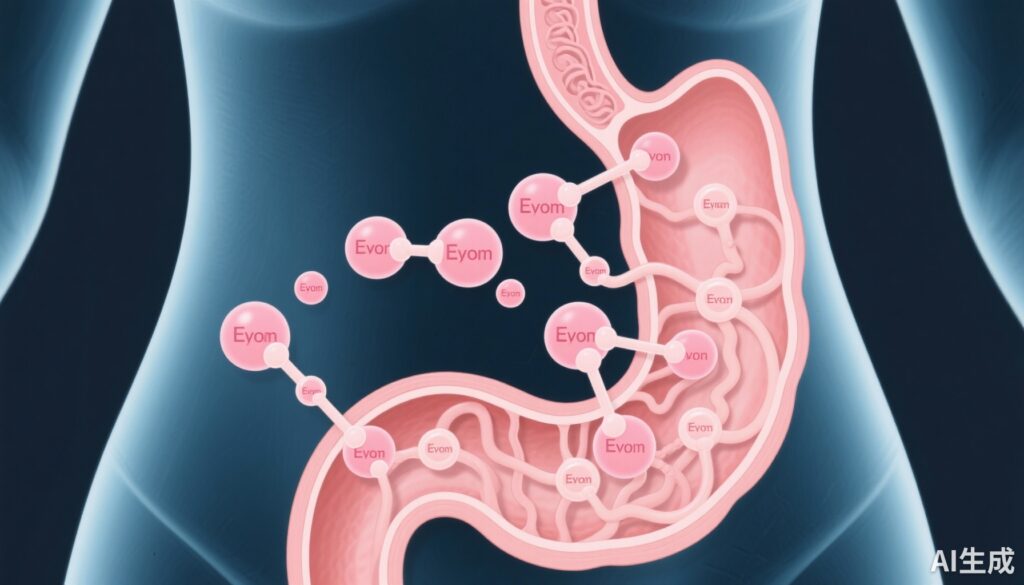ハイライト
北欧5カ国からの最近の大規模な証拠では、閉経期ホルモン療法(MHT)の使用が、非使用者と比較してエソフィアがんと胃がんの発症リスクを最大30%低減することに関連していることが明らかになりました。リスク低減は、組み合わせたエストロゲン-プロゲステロン療法と全身ホルモン製剤で最も強かったです。これらの知見は、エストロゲンが上部消化管(GI)のがん化に保護的な役割を果たすことを支持しています。
研究の背景
上部消化管がん、特に食道腺がん(EAC)、食道扁平上皮がん(ESCC)、胃腺がん(GAC)は、予後が不良で発症率が増加しており、世界中の重要な健康問題となっています。特にEACの発症率が上昇しています。これらのがんには男性の優位性があり、これが性ホルモンの影響についての調査を促進しています。閉経後、エストロゲンレベルは急激に低下し、高齢女性のがんリスクが増加する可能性があります。以前の研究では、閉経期ホルモン療法と消化管がんリスクとの関連について一貫性のない限定的なデータが得られていました。
研究デザイン
この包括的なケースコントロール研究では、デンマーク、フィンランド、アイスランド、ノルウェー、スウェーデンの1994年から2020年までの全国処方薬、がん、人口登録データベースを統合したノーティック消化管腫瘍研究(NordGETS)データベースを使用しました。本研究には、45歳以上のEAC、ESCC、またはGACと診断された19,518人の女性と、年齢、暦年、国別に1:10の比率でマッチングされた195,094人の対照群が含まれました。
MHTの曝露は、定義された1日の用量(DDD)に基づいて、低用量(848 DDDs)の3つのグループに分類され、全身または局所(膣内)およびホルモンタイプ:単独エストロゲン療法と組み合わせエストロゲン-プロゲステロン療法に分類されました。主要なアウトカムは、年齢、肥満、喫煙、アルコール摂取、胃食道逆流症、ヘリコバクター・ピロリ除菌、スタチンやNSAIDsの使用などの混雑因子を制御した3種類のがんの調整オッズ比(aORs)でした。社会経済的要因は調整されていません。
主な知見
MHTを使用している女性は、すべての上部消化管がんにおいて統計的に有意なリスク低減が観察されました:
- 食道腺がん(EAC): aORsは、低用量(0.74)、中用量(0.68)、高用量(0.68)で、約26-32%のリスク低減が示されました。用量依存性の保護効果が観察されました。
- 食道扁平上皮がん(ESCC):同様の逆相関が観察され、用量に関わらずaORsは約0.69-0.71でした。
- 胃腺がん(GAC): MHTの用量が高いほどリスクが漸進的に低下し、低用量(0.90)から高用量(0.80)まで、保護効果が示されました。ただし、食道がんよりも効果は弱いでした。
ホルモン製剤による層別分析では、組み合わせエストロゲン-プロゲステロン療法と全身MHTが最も強い保護効果を示しました。EACの場合、全身MHT使用者のaORは0.67であり、局所膣内療法では若干効果が弱まり(aOR 0.72)ました。同様に、組み合わせエストロゲン-プロゲステロン療法は、EAC、ESCC、GACにおいて単独エストロゲン療法よりもより大きなリスク低減をもたらしました。
これらの結果は、エストロゲンシグナル伝達経路が上部消化管のがん化を制御する可能性があることを示唆しており、上皮の整合性やニトリックオキサイドを介した平滑筋の調節に影響を与える可能性があります。
専門家のコメント
これらの結果は、閉経期ホルモン療法と上部消化管がんリスクの逆相関関係に対する最大かつ最も厳密な支持の一つを提供しています。カロリンスカ研究所のヴィクトリア・ウォカレフスキ博士は、研究の信頼性は広範なサンプルサイズ、重要な混雑因子への調整、およびホルモン製剤と用量の詳細な分析にあると強調しています。
生物学的には、エストロゲンは上皮のタイトジャンクションを強化し、慢性粘膜炎症を軽減し、硝子体合成を調節することで平滑筋機能と粘膜血流に影響を与えることで保護作用を果たす可能性があります。これらのメカニズムは、閉経前の女性やホルモン療法使用後の上部消化管がんの発症率が低いという疫学的観察と一致しています。
限界には、社会経済的地位の調整がないこと、潜在的な残存混雑因子、観察研究固有の因果関係の確立不能があります。今後、前向き研究とメカニズム研究が必要であり、これらの知見を確認し、ホルモン状態を組み込んだ個別化予防戦略を策定する必要があります。
結論
この大規模な人口ベースのノーティック研究は、閉経期ホルモン療法がエソフィアがんと胃がんのリスクを有意に低減することを堅実に示しています。特に、組み合わせエストロゲン-プロゲステロン全身療法での効果が強く、エストロゲンシグナル伝達が上部消化管のがん化に保護的な役割を果たす可能性を強調しています。これらの知見は、性ホルモンが消化管がんの生物学に与える影響の理解を深め、これらの悪性腫瘍のリスクが高い閉経後の女性向けの個別化予防戦略を策定するのに役立つ可能性があります。
臨床医は、MHTのリスク-ベネフィットプロファイルの全体的な文脈でこれらの知見を考慮すべきであり、研究者には、基礎的な生物学的メカニズムのさらなる調査とこれらの疫学的関連を臨床実践に翻訳することが奨励されます。
参考文献
- Wocalewski V. 閉経期ホルモン療法と食道・胃がんリスク:ノーティック人口ベースの研究. United European Gastroenterology (UEG) Week 2025.
- Camargo MC, et al. 性ホルモンと食道腺がん:系統的レビュー. Cancer Epidemiol Biomarkers Prev. 2012.
- Reynolds P, et al. ホルモン補充療法と食道がん・胃がんのリスク. Am J Epidemiol. 2007.
- James PD, et al. エストロゲンが消化管腫瘍発生に果たす役割:臨床的および実験的研究からの洞察. Front Endocrinol (Lausanne). 2021.



